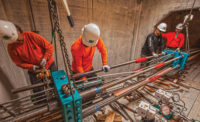Studies show that wildlife-vehicle collisions have doubled in the past 15 years in the Intermountain West, says Rob Ament, ecology program manager for the Western Transportation Institute at Montana State University in Bozeman.
Ament says the reasons for collisions can vary from the presence of high-quality habitat at the road’s edge to animals moving from winter to summer ranges. Another factor is winding roads with poor visibility.
The increase in collisions has spurred transportation agencies to identify major wildlife corridors and engineer solutions to prevent accidents.
One solution includes wildlife crossings that connect habitats divided by highways. The crossings involve site-specific engineering and construction of underpasses and overpasses for large animals such as moose, elk and deer to cross roads safely. Design solutions also include tunnels for small mammals such as otters, skunks, badgers and amphibians. Some aquatic crossings allow for fish migration.
Gregg Servheen, wildlife programs coordinator for Idaho Fish and Game, says new road development or improvements in his state will address wildlife and public safety with engineered strategies for underpasses and overpasses.
“Underpasses are probably the most common way of dealing with wildlife connectivity,” Servheen says. “It’s not only important to protect animals but it is also a public safety issue.”
The People’s Way, Montana
In northwestern Montana, the People’s Way is a 56.3-mile section of U.S. Hwy. 93 between Evaro and Polson south of Flathead Lake, with all but 1 mile on the Flathead Indian Reservation. This stretch of roadway represents the most extensive wildlife-sensitive highway design effort in North America to date.
Many uncommon native species live within the project area, including grizzly bears and gray wolves. There also are black bear, white-tailed and mule deer, bobcat, coyote, mountain lion, elk and the western painted turtle.
The Montana Dept. of Transportation has built 42 fish- and wildlife-crossing structures and nearly 17 miles of wildlife fencing, plus specially engineered overpasses and underpasses.
Great Western Engineering of Helena designed the 7-mile-long and southernmost section of the People’s Way from Evaro to McClure Road. The $29-million section includes a 1.5-mile extension of a four-lane undivided roadway and a two-lane roadway with turn lanes and alternating passing lanes for north and southbound traffic.
GWE also engineered the relocation of 1 mile of Montana Rail Link line, including a new railroad bridge in Evaro, 3.5 miles of wildlife fencing, and 10 wildlife-crossing structures, including an overcrossing designed for grizzly bears.
Dan McCauley, GWE president, says a lot of biological study was involved before the design phase started. “We coordinated with the tribes and various federal and state agencies to engineer the proper structures, along with road engineering,” he says. “After years of study, it was determined that the overcrossing at the top of Evaro Hill is located in the best grizzly bear habitat on the entire stretch of U.S. 93.”
Of the 10 GWE-designed undercrossings, six are essentially large, bottomless, oversized culverts placed over streams that include a path along the side where animals from mountain lions to turtles can get safe passage.
There also are more than 16 total miles of 8-ft-high wildlife fencing on both sides of the road that keep animals off the highway and steer them into the passageways.
Togwotee Trail, Wyoming
The Togwotee Trail is a 38-mile section of U.S. Hwy. 26-287 between Dubois and Jackson along one of the country’s most scenic roadways. A large wildlife crossing allows passage under the section known as Buried Bridge, so named because the bridge is built under the highway and crosses above the wildlife crossing, making both undetectable to motorists.
Cody Beers, a public relations specialist for the Wyoming Dept. of Transportation, says standard bridges have a tendency to become icy during the winter, causing hazardous traveling conditions. To avoid these conditions, WYDOT chose to borrow a Canadian engineering idea.
The bridge was constructed near Mile Post 24 at more than 9,000 ft along a known migration route for deer and elk. After the bridge was completed, WYDOT crews covered it with 5 ft of dirt and then built the road over the dirt.
I-15 Wild Cat, Utah
Monte Aldridge, Utah Dept. of Transportation Region 4 preconstruction engineer, says that before his agency built the Wild Cat crossings on Interstate 15 in Beaver County in 2004, there were on average 300 deer-car collisions per year. After the crossings and fencing were installed, the incidents dropped to less than 10 per year, he adds.
Aldridge says that UDOT installed two massive culverts approximately 2 miles apart. “We also placed approximately 20 miles of wildlife fencing, 10 miles on each side of the highway, to funnel the deer to the crossings and keep them off the highway,” he says.
The location was critical to the animals’ ability to use the crossing, Aldridge says. “We had to locate the crossings in areas that are naturally being used by wildlife, allowing them to have a good view of the facility so they can locate it and use it,” he adds.
West Vail Pass, Colorado
In Colorado, the 18-mile section of Interstate 70 known as West Vail Pass has been chosen as the official site for the North American Wildlife Crossing Structure Design Competition, or ARC. The competition involves an area at 10,000 ft about 70 miles west of Denver.
Over the last decade, information about the use of the crossing structures by large mammals has been collected at 24 sites in the United States and Canada, creating the ARC database.
The ARC competition will bring together landscape architects, construction architects, engineers, ecologists and other experts to design safe, efficient, cost-effective and ecologically responsive future wildlife crossings.
The competition will begin in June and participants will have six weeks to submit a design. Five finalists will be chosen and awarded $15,000 to complete their proposal with the winner receiving $45,000 at a nation transportation conference in Washington, D.C. in January 2011.










Post a comment to this article
Report Abusive Comment